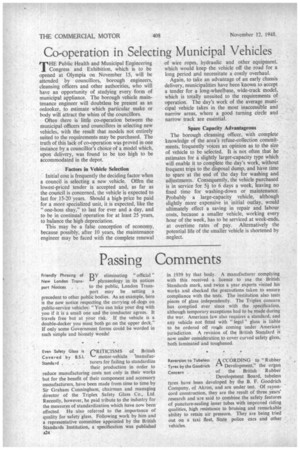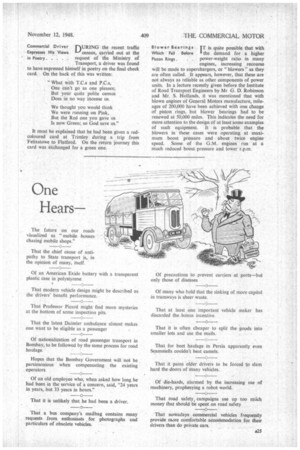Passing Comments
Page 26

Page 27

If you've noticed an error in this article please click here to report it so we can fix it.
Friendly Phrasing ofeliminating " official "
New London TransYphraseology in its notices
port Notices . . to the public, London Trans port may be setting a precedent to other public bodies. As an example, here is the new notice respecting the carrying of dogs on public-service vehicles: "You can take your dog with you if it is a small one and the conductor agrees. It travels free but at your risk. If the vehicle is a double-decker you must both go on the upper deck." If only some Government forms could be worded in such simple and timely Words!
Even Safety Glass Is CRITICISMS of British Covered by B.S.I. motor-vehicle inanufac
Standard turers for failing to standardize their production in order to reduce manufacturing costs not only in their works but for the benefit of their component and accessory manufacturers, have been made from time to time by Sir Graham Cunningham, chairman and managing director of the Triplex Safety Glass Co., Ltd. Recently, however, he paid tribute to the industry for the measures of standardization which have now been effected. He also referred to the importance of quality for safety glass. Following work by him and a representative committee appointed by the British Standards Institution, a specification was published A24 in 1939 by that body. A manufacturer complying with this received a licence to use the British Standards mark, and twice a year experts visited his works and checked the precautions taken to ensure compliance with the tests. The institution also tests pieces of glass independently. The Triplex concern has complied ever since with the specification, although temporary exceptions had to be made during the war. American law also requires a standard, and any vehicle not fitted with " legal" glass is liable to be ordered off rods coming under American jurisdiction. A revision of the British Standard is now under consideration to cover curved safety glass, both laminated and toughened.
Reversion to Tubeless A CCORDING to "Rubber Tyres by the Goodrich r-s• Development," the organ
Concern of the British Rubber Development Board, tubeless tyres have been developed by the B. F. Goodrich Company, of Akron, and are under test. Of rayoncord construction, they arc the result of three years' research and are said to combine the safety features of puncture-sealing inner tubes with improved riding qualities, high resistance to bruising and remarkable ability to retain air pressure. They are being tried out on a taxi fleet, State police cars and other vehicles. Commercial Driver URING the recent traffic Expresses His Views L'f census, carried out at the in Poetry request of the Ministry of Transport, a driver was found to have expressed himself in poetry on the final check card. On the back of this was written: " What with T.C.s and P.C.s, One can't go as one pleases; But your quite polite census Does in no way incense us.
We thought you would think We were running on Pink, But the Red one you gave us Is now Green; so God save us."
It must be explained that he had been given a redcoloured card at Trimley during a trip from Felixstowe to Flatford. On the return journey this card was exchanged for a green one. Blower Bearings IT is quite possible that with Which Fail Before the demand for a higher Piston Rings. power-weight ratio in many engines, increasing recourse will be made to superchargers, or " blowers " as they are often called. It appears, however, that these are not always as reliable as other components of power units. In a lecture recently given before the Institute of Road Transport Engineers by Mr G. D. Robinson and Mr. S. Hollands, it was mentioned that with blown engines of General Motors manufacture, mileages of 200,000 have been achieved with one change of piston rings, but blower bearings had to be renewed at 50,000 miles. This indicates the need for more attention to the design of at least some examples of such equipment. It is probable that the blowers in these cases were operating at maximum boost pressure and about twice engine speed. Some of the G.M. engines run at a much reduced boost pressure and lower r.p.m.




























































































